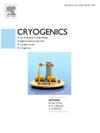Mass flow and entropy production in choked 4He gas flow through micro-orifices
IF 1.8
3区 工程技术
Q3 PHYSICS, APPLIED
引用次数: 0
Abstract
Micro-orifice is a critical component in cryogenic refrigeration systems that determines the mass flow rate and total cooling power. However, a sophisticated model to accurately predict mass flow rates, especially for helium (He) below its maximum inversion temperature, where its properties differ significantly from those of an ideal gas, is lacking. This study investigated the mass flow characteristics and entropy production of 4He gas flow in micro-orifices using computational fluid dynamics (CFD) simulations. Various conditions, including upstream temperatures, upstream pressures, and downstream pressures, were analyzed and compared with the predictions from the Maytal model. Our results show that entropy production due to velocity and temperature gradient fluctuations plays a significant role in determining flow rates. Under upstream conditions of 15 K, 0.7 MPa, and a 20 μm diameter, the entropy increase coefficient (δ) is 0.083. Neglecting this entropy production leads to an overprediction of the mass flux by 39.8 %. A modified Maytal model that accounts for entropy production yields predictions in better agreement with CFD simulations, with a maximum deviation of less than 6.3 %. This work highlights the critical role of entropy production in 4He gas flow through micro-orifices and offers guidance for selecting micro-orifices in cryogenic applications.
呛入的 4He 气体流经微孔时的质量流和熵产生
微孔是低温制冷系统中的一个关键部件,它决定着质量流量和总制冷功率。然而,目前还缺乏一个复杂的模型来准确预测质量流量,特别是低于最高反转温度的氦气(He)的质量流量,因为氦气的特性与理想气体有很大不同。本研究利用计算流体动力学(CFD)模拟研究了微孔中 4He 气体流动的质量流特性和熵产生。研究分析了各种条件,包括上游温度、上游压力和下游压力,并与 Maytal 模型的预测结果进行了比较。结果表明,速度和温度梯度波动导致的熵产生在决定流速方面起着重要作用。在 15 K、0.7 MPa 和 20 μm 直径的上游条件下,熵增加系数 (δ) 为 0.083。忽略熵的产生会导致质量通量预测过高 39.8%。考虑到熵产生的修正 Maytal 模型得出的预测结果与 CFD 模拟结果更为一致,最大偏差小于 6.3%。这项工作强调了熵产生在 4He 气体流经微孔时的关键作用,并为低温应用中选择微孔提供了指导。
本文章由计算机程序翻译,如有差异,请以英文原文为准。
求助全文
约1分钟内获得全文
求助全文
来源期刊

Cryogenics
物理-热力学
CiteScore
3.80
自引率
9.50%
发文量
0
审稿时长
2.1 months
期刊介绍:
Cryogenics is the world''s leading journal focusing on all aspects of cryoengineering and cryogenics. Papers published in Cryogenics cover a wide variety of subjects in low temperature engineering and research. Among the areas covered are:
- Applications of superconductivity: magnets, electronics, devices
- Superconductors and their properties
- Properties of materials: metals, alloys, composites, polymers, insulations
- New applications of cryogenic technology to processes, devices, machinery
- Refrigeration and liquefaction technology
- Thermodynamics
- Fluid properties and fluid mechanics
- Heat transfer
- Thermometry and measurement science
- Cryogenics in medicine
- Cryoelectronics
 求助内容:
求助内容: 应助结果提醒方式:
应助结果提醒方式:


